Trapping is widely used for feral cat control in Australia. With training, cat trapping is a relatively simple method where non-lethal traps are set and monitored. Trapped animals can then be euthanised, removed from the environment or released if not the target.
Traps use food, scent or visual lures to attract feral cats into the trap, where the trap is triggered capturing the live cat. Trapping is one of the only methods available for feral cat control in most states.
Trapping is most useful for targeting problem animals, protecting specific assets in smaller areas, such as native wildlife and in urban areas (cages only).
A number of trap designs are available for use in Australia. Trap designs vary but typically belong in one of four categories: cage traps, padded-jaw traps (soft-jawed leg-hold traps), soft net traps, and snares. Padded-jaw and cage traps are the most commonly used for feral cat management.
Each trap type has advantages and things to consider. Program managers often use a mixture of traps because some individual animals avoid particular trap types and, at different times of the year, off-target species like goannas may be more active and impacted by padded-leghold traps. Traps that contain an animal, such as cage traps, are considered more humane because they are less likely to cause injury than traps that restrain an animal, such as padded-jaw traps or snares.
Trapping has traditionally been a cost- and effort-intensive process because large numbers of traps must be laid and checked daily.
Newly developed electronic systems are increasingly used as part of trapping programs to alert program managers to triggered traps. These systems substantially reduce the cost and effort of these trapping programs and increase animal welfare outcomes.
Using traps and snares in feral cat control is regulated in Australia and the allowed types, and what you can do with trapped cats, vary depend on legislation in your state or territory.
Before setting any trap, you must know what you are going to do with any animal caught.
Steps should be taken to protect the welfare of trapped animals. For example as covering the cage with shade cloth and providing water during hot conditions and providing bedding in cold conditions. Traps should be checked at least every 24 hours.
According to the National Standard Operating Procedure: Methods of euthanasia the most humane method of killing a feral cat in a trap is using a shot to the brain with an appropriate firearm or an overdoes of barbiturates.
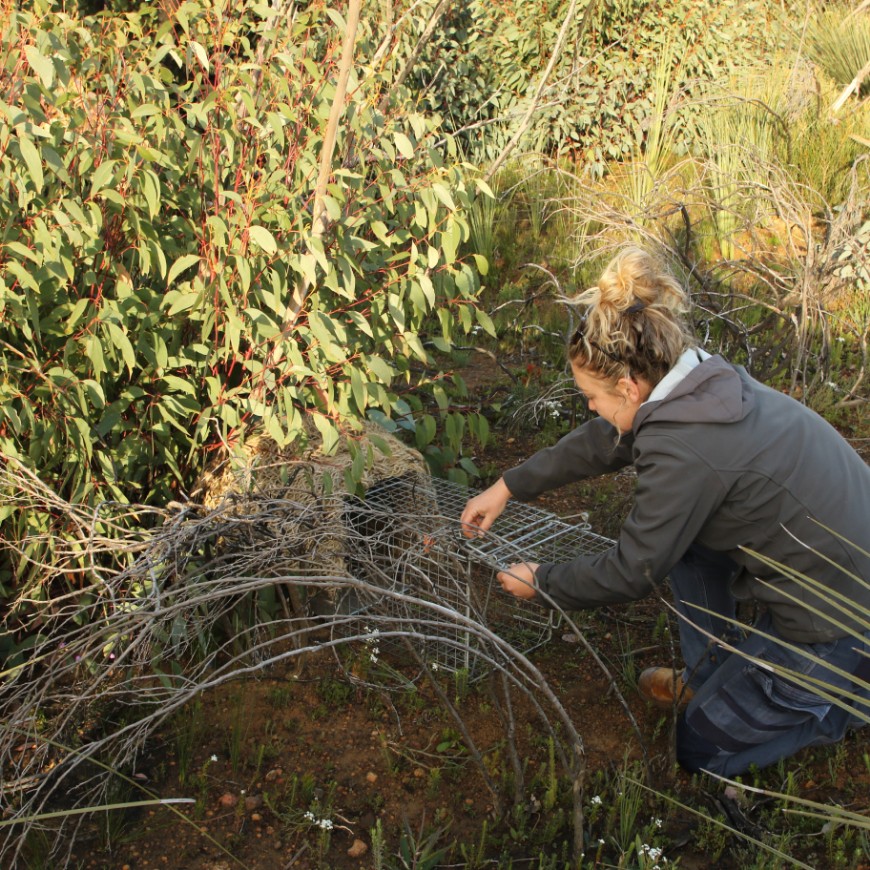
Take measures to protect the welfare of trapped animals. Photo: CISS, NFCFMC Program.
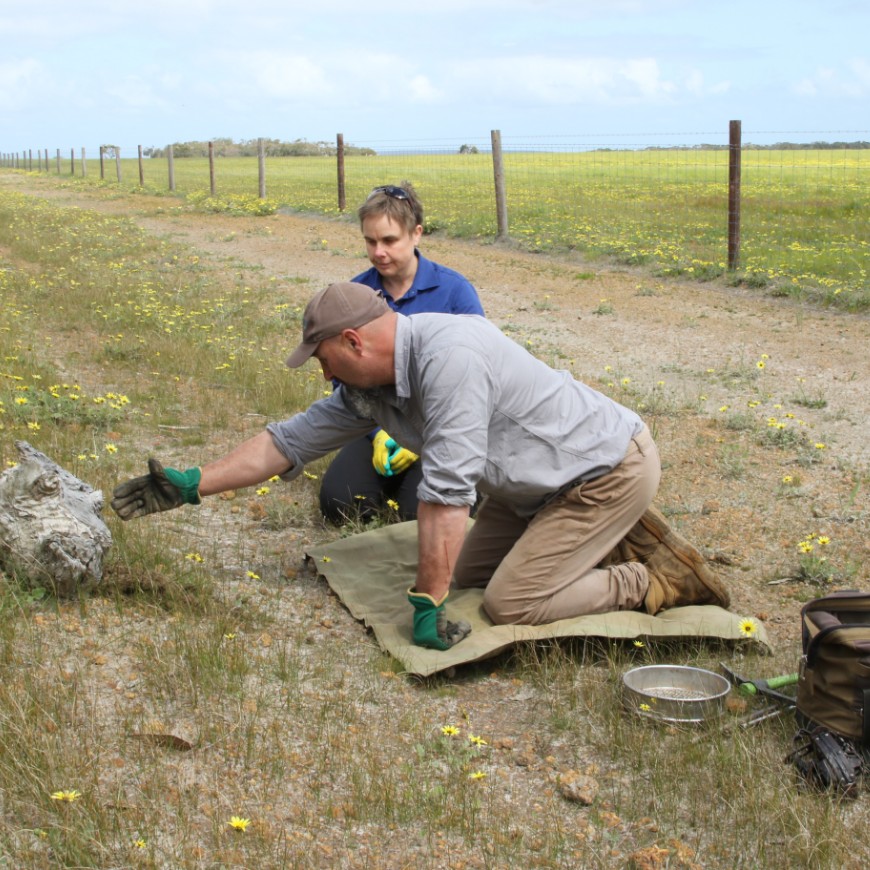
With training, cat trapping can be an effective feral cat control method that is available in most jurisdictions. Photo: CISS, NFCFMC Program.
Trap types
Cage traps
Cage traps consist of a wire-mesh cage with a sprung door. When a cat enters the cage, the door is triggered by the animal’s weight on a treadle or it pulling at a bait, trapping them inside. Off-target animals can be released easily from a cage trap, injury may be reduced and trapped feral cats can be transported away from the area, if need be, for euthanasia. Feral cats can be wary of entering a cage trap, particularly smaller cages, and can escape from cages if they are too short or too flimsy.
National Standard Operating Procedure: Trapping of cats using cage traps
Padded-jaw traps
Padded-jaw traps consist of two padded jaws connected to a spring-loaded mechanism that snaps shut on the leg of an animal when triggered. Padding, and limits to how tightly a trap can close, reduce the risk of injury to the animal during capture. Padded-jaw traps may be more effective than cage traps for hard-to-catch feral cats that are reluctant to enter cage traps. Padded-jaw traps are often ‘baited’ with a sent or visual lure rather than food, making them more effective when feral cats are not hungry. There may be some restrictions in the use of padded-jaw traps for feral cats in your state or territory. Steel-jaw traps are prohibited for feral cats in all Australian states and territories.
National Standard Operating Procedure:Trapping of feral cats using padded-jaw traps
Soft net traps
Soft net traps consist of a mesh net structure connected to a trigger or pressure plate that wraps around the animal when triggered. Soft net traps are typically used in situations where an animal is unable to be caught with a cage trap and using padded-jaw traps or snares is restricted. Soft net traps combine the functions of cage traps, padded-jaw traps and snares because they can capture an animal less conspicuously than a cage trap, and are less likely to cause injury than a padded-jaw trap or a snare. However, currently, there are no manufacturers or distributors of soft net traps suitable for capturing feral cats in Australia.
National Standard Operating Procedure: Trapping using soft net traps.
Snares
Snares trap an animal by grasping or entangling a part of their body. While being less visible to feral cats than a cage trap, they can be difficult to set, are bulky to carry and may miss more target animals. Only specific designs of snare can be used in Australia for feral cats, such as treadle snares, which consist of a pressure plate connected to a loop that wraps around the paw of the animal when triggered.
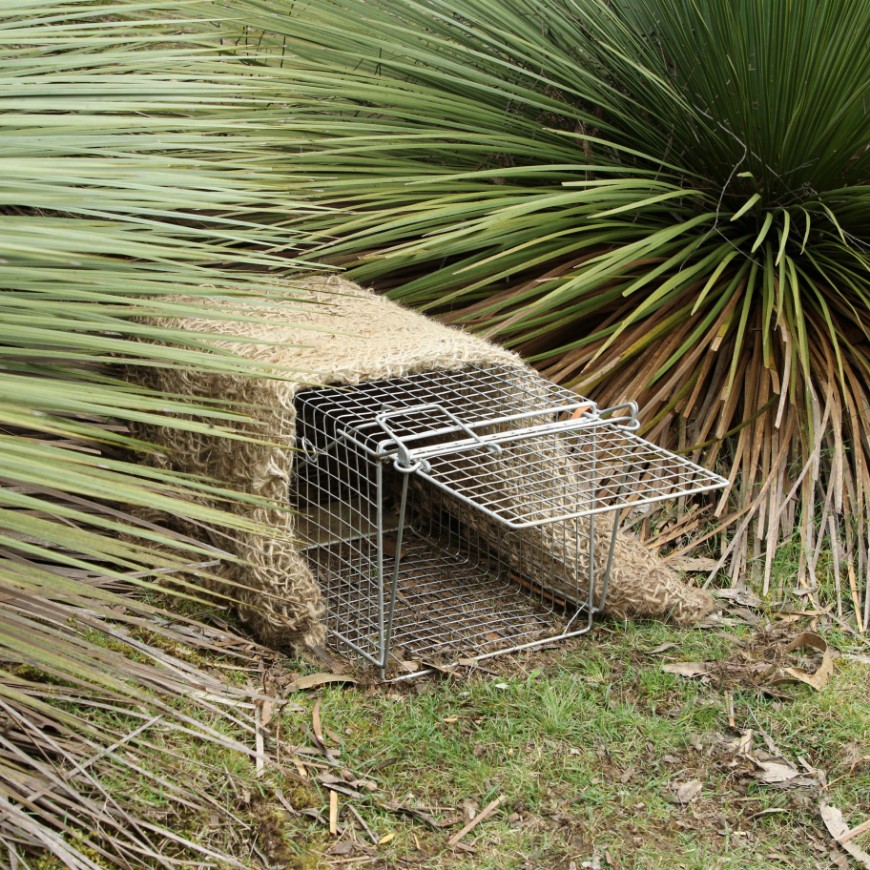
Cage (above) and leghold traps are the most used trapping methods for feral cats. Photo: CISS, NFCFMC Program.
Advantages of trapping
- If traps are used correctly, captured animals are usually unharmed.
- Cage trapping is the only method easily available in every state and territory. (Euthanasia of trapped feral cats is not allowed on all land tenures in Tasmania, Victoria, or South Australia).
- Trapped cats can be checked for identification collars, tags and microchips.
- Traps are usually non-destructive, allowing for live collection of data from target animals (e.g. allows GPS collaring or collecting measurements that may be missed with a baiting program).
- The range of traps helps to target hard-to-trap animals. For example, padded-jaw traps are useful for animals that are reluctant to enter cage traps. Trap design can also increase species selectiveness.
- Cage trapping is useful in urban areas for problem animals where other tools are inappropriate.
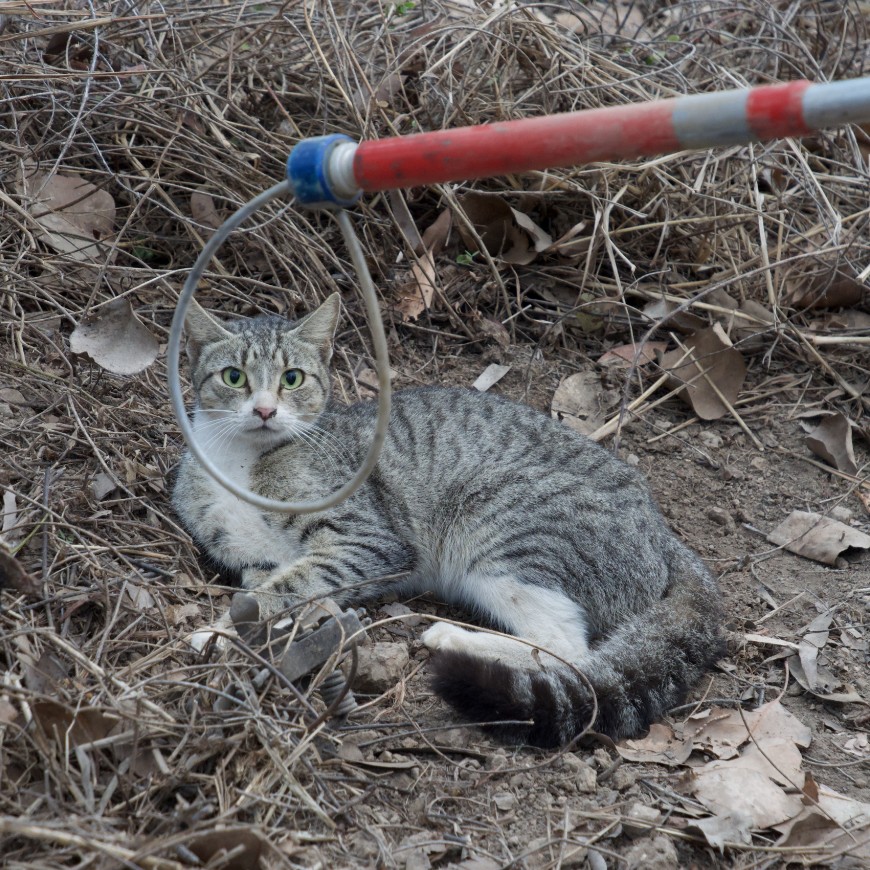
Trapping allows for live capture of feral cats to check for microchips or to put GPS collars on them. Photo: Judy Dunlop.
Things to consider when trapping
- Always know what you are going to do with a trapped animals before setting a trap.
- As trapping is labour- and cost-intensive, it is usually not appropriate for landscape-scale control.
- Trapping must be done in accordance with relevant animal welfare or prevention to animal cruelty Acts and Regulations, which means animals must not be subject to unnecessary stress, exposure or harm, and reasonable care must be taken to ensure other animals are not harmed.
- Cage and padded-jaw traps are the most common types used for feral cat control. State and territories have regulations about when and how traps can be set, particularly padded-jaw traps.
- According to the National Standard Operating Procedure: Methods of euthanasia, humane euthanasia methods for trapped feral cats is with a firearm or overdose of barbiturate.
- All traps have the potential to cause injury and some degree of suffering and distress, so traps should only be used when there is no other practical alternative. Some trap designs, such as padded-jaw traps, have a higher chance than other designs of inflicting injuries on the trapped animal.
- Traps must be checked every day and protected from severe weather conditions.
- Most traps are not target-specific, so they may catch off-target animals. Selection of trap types, placement and bait or lure type can reduce this.
- Trapping alone, especially at a landscape scale, will not reduce cat populations enough for effective control. Other methods will also be needed.
- Feral cats can be wary of human infrastructure and may not be captured by a trap, particularly cages.
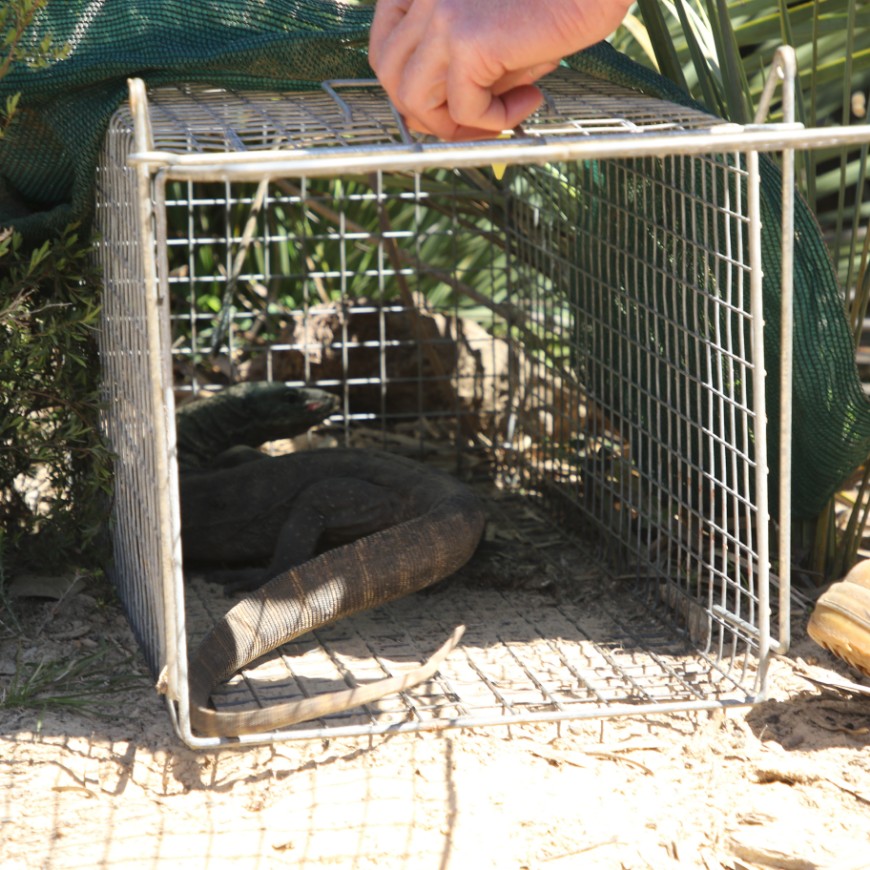
Selecting trap and lure type, as well as trap placement, will help reduce capture and injury to off-target species like this Rosenberg’s goanna. Photo: CISS, NFCFMC Program.
Effective use
Trapping is a useful tool in feral animal control due to its relative simplicity, repeatability and reduced risk of harm to off-target animals.
Trapping is generally considered ineffective for landscape scale programss due to the resource intensiveness and need for extensive access for large-scale trapping programs. New ‘trap alert’ systems may reduce cost and labour requirements and increase animal wealfare as traps with animals in them can be checked quickly.
Humane and successful trapping requires extensive training and experience. Trapping by inexperienced operators can result in ‘trap-shy’ feral cats that are difficult to catch because they have previously escaped from a carelessly prepared and presented trap. Similarly, poor technique can result in greater rates of injuries and off-target captures.
Trapping is best used in areas where other methods are not available or are inappropriate, or in combination with other tools. Trapping is commonly used in urban or residential areas where domestic animals are present, or where feral cat populations have already been reduced and individual cats need to be caught or where feral cat control is targeted to specific sites. These include high-value threatened species populations in limited areas, source areas like rubbish tips, sinks like outside predator-proof exclosures or narrow pathways like peninsulars or waterways in arid areas.
Traps should be strategically positioned in areas frequented by feral cats, but off to the side of animal tracks or roads so that they do not get accidently set off or catch an off-target animal. Do not set traps where you think pets or livestock are likely to be caught or trigger it. Feral cats can be drawn to traps with use of bait, sound, visual or scent lures.
Trapping is most effective during night-time due to the nocturnal habits of feral cats. Regular checks of the traps are crucial to reduce stress on trapped feral cats. Traps legally need to be checked at least once every 24 hours. If practical, such as in urban areas, set traps in the afternoon, then inspect them early in the morning and keep them closed throughout the day.
Take measures to protect the welfare of trapped animals. For example, cover cages with shadecloth or wedge them under vegetation and do not trap when conditions are likely to be wet or extremely hot or cold. Traps should not be set where there is a risk of entanglement with fences or thick vegetation as this can cause injury to the trapped animal. Trapped cats should be approached carefully and quietly to minimise panic, further stress and risk of injury.
In areas where it is a risk, trapped cats must be checked to determine if they are pets. Feral cats must be destroyed as quickly and humanely as possible. In most cases, this will be with a single rifle shot to the brain.
Off-target animals that are caught, but not injured, should be released at the trap site. If they are injured, you should seek veterinary treatment for them if required. If an animal is severely injured during trapping, they may need to be euthanised, and this should be undertaken quickly and humanely.
To be effective and to ensure best practice trapping for feral cat control you should comply with:

Traps should be strategically placed in areas frequented by feral cats are such as fence lines, beside tracks, areas of high food resources, interesting landscape features. Photo: CISS, NFCFMC Program.

Rats and other animals may take baits from traps. There are a range of ways to stop this happening. Photo: CISS, NFCFMC Program.
Laws for trapping feral cats
Trapping must be done in accordance with relevant animal welfare or prevention to animal cruelty Acts and Regulations, which means animals must not be subject to unnecessary stress, exposure or harm, and reasonable care must be taken to ensure other animals are not harmed.
Appropriate and permissible trap types depend on the legislation in your state or territory. Permits and approval are required for some traps, particularly padded-jaw traps, in some states. Training on how to effectively set and check traps is highly recommended.
You must have landholder or land manager permission if trapping on someone else property or public land.
Contact your state or territory for more information on regulatory requirements for your program.
Banner Photo: Sue Stelzer.
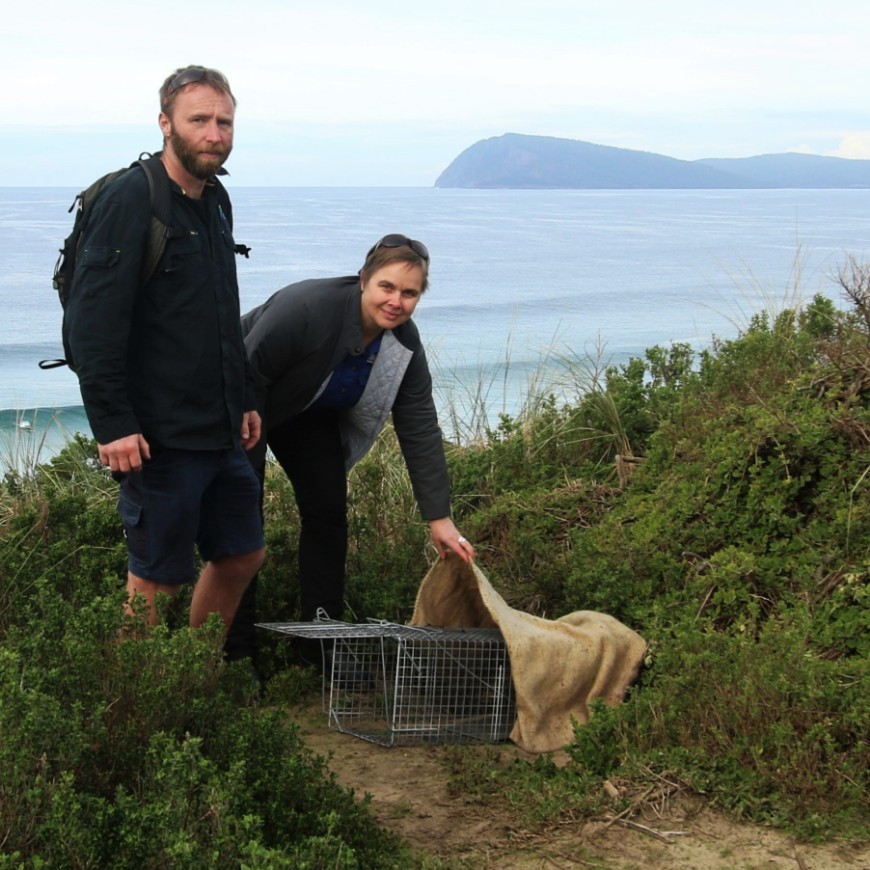
Traps must be checked at least once every 24 hours. Photo: CISS, NFCFMC Program.
